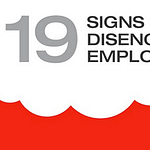The success of your business is entirely dependent upon how successful your customers are in using your product or service. When customers can achieve their goals with your solution, they remain loyal, and you will stay in business.
| According to D&B company, 65% of a company’s business comes from existing customers, prompting companies to build dedicated customer success teams. |
However, the customer success function is not limited to one group. It is a holistic approach that involves a highly engaged internal workforce, which ensures that the quality of the product delivered and the experience customers have with it is at its highest. The factor that drives motivation and engagement is positive employee experience.
What Customer Success is
| Customer success (CS) is a business effort executed by companies to ensure customers achieve their desired outcome when using their product or service. |
The rise of customer success as a function can be attributed to the growth of Software as a Service (SaaS) and other subscription business models.
Deloitte says that close to 80% of customers depend on the technical support given by solution providers in the SaaS industry. Therefore, customer success teams are essential to proactively support and address customers’ needs even before they reach out. In a nutshell, customer success ensures that customers can unlock the full potential of the service they have subscribed to for their businesses.
What Employee Experience is
| Employee experience (EX) is the sum of all experiences a person goes through in their journey as an employee in an organisation. |
EX starts from the onboarding process, interactions with the HR teams and co-workers, and continues with the overall experience at the workplace (in terms of culture, peer interactions, work environment, facilities offered, and more.)
A positive employee experience is crucial, as it determines their intent to stay and impacts their productivity through motivation and engagement.
The Link between Employee Experience and Customer Success
Employee experience is a significant factor in employee engagement. Highly engaged employees are enthusiastic and fully absorbed into their roles. Their positive experience at the workplace motivates them to adhere to the organisation’s “customer first” principle and work towards delivering the best customer experience.
It is vital to position CS as part of every employee’s role to truly achieve customer success and not just the CS teams. Every interaction at every touchpoint the customer has with your company should add value and leave a positive and memorable impression. True customer success can be achieved only when the leadership aligns every department’s mission (design, sales, finance, or support) to contribute to CS. This is possible only when employees are engaged through a positive employee experience.
7 Strategies for Positive Employee Experience at the Workplace
Delivering a great employee experience is a continuous process. Here are a few ideas to improve employee experience at your workplace:
Positive experience starts at recruitment
- When considering EX, every moment of the employee’s journey must be considered, including the time before they are hired.
- Recruitment is the first opportunity to hint at what the prospect can expect regarding the work culture, organisational attitudes and communication.
- Every prospective candidate would have researched the organisation before applying for a position. This is the right time to set the tone and show off the organisation’s “vibe” to reinforce their beliefs or make corrections.
Wow them with salary, rewards, and recognition
- Competitive salaries used to be the main reason for people to choose employers. However, it is not the case anymore. In the post-covid world, employees look forward to a great workplace culture rather than just salary packages.
- Today, employees want to feel valued at work and seek higher fulfillment from their work. With that said, offer plenty of perks such as flexible work schedules and timely rewards and recognition to show that they matter.
Make a strong first impression at onboarding
- The first impression can make or break a new hire’s perspective on the organisation. Hence, onboarding must be ‘spot on’ to create the right impression.
- Failing to impress employees during their onboarding involves a risk. The risk of losing them within the first few months.
- A positive onboarding experience prompts new hires to look at the bright side of things and even acts as a buffer to any lapses in good experience on the way.
Build effective communication channels
- The key to building relationships and a healthy working atmosphere is establishing good communication within the organisation.
- Employees need to feel safe communicating what they think to their peers, HR and even the higher management.
- Fostering transparency and an open communication culture makes employees feel important as their voice matters.
- Companies can use multiple internal communication channels, including social media, to ensure everybody can communicate in the most comfortable way.
Conduct surveys
- Regular surveys are a powerful tool to assess how employees are doing and give you better insights into what can be expected.
- Surveys don’t have to contain long lists of questions handed quarterly or yearly. Short pulse surveys are a great tool to assess employee perspectives and the overall work environment.
- With surveys, you get honest answers that can be quickly incorporated into your feedback mechanism to bring necessary changes.
Make it about the employees
- The focus should be on building a great experience throughout the employee lifecycle. From onboarding, to departure, every interaction is an opportunity to create a positive employee experience.
- Assess the organisational culture, the goals, the values, and the processes implemented in place for their ability to create a positive experience.
- Continuously improve things that can contribute to a good employee experience.
Invest in career development
- Growth opportunity is one of the critical factors employees consider before choosing an organisation.
- Employees will be highly motivated to perform at their peak in their job roles when they know that you are investing in furthering their careers.
- Career development can include higher pay, essential duties, better job titles, job-specific training and opportunities to work with teams outside the organisation.
Focus on employee wellness
- The strongest message you can ever send to your employees is how you care for them. An ideal way to do this is by investing in their wellness.
- Empathise with your employees and work on improving their pain-points and not just acknowledging them.
- Offer wellness programmes that help de-stress and improve their health. Unhealthy employees not only have poor experience but are also unproductive.
- Offer advice on how to balance their work with a healthy lifestyle. Arrange seminars on valuable subjects such as financial management as many people are not adept at finances. Helpful advice can boost their confidence and positive experience.
Ensure a positive exit experience
- Positive employee experience as a goal is never complete unless employees have a positive exit experience. It is just as crucial for the organisation that the employee leaves on good terms as it is for the employee.
- Poor or negative exit experiences can damage the employer’s brand and the organisation’s ability to hire the best talent. A Gallup study shows that employees who have a positive exit experience are 2.9 times more likely to recommend their former employer than those who have had a neutral or negative exit experience.
- Ensure a positive exit experience by hearing their feedback and making them proud of their contributions.
Conclusion
When you factor in the variables contributing to employee experience, you will soon realise that customer success starts within the organisation. Positive employee experience is central to a highly motivated, engaged, and productive workforce. It encourages employees to perform at their best while taking responsibility for the bigger picture of customer success.
Author: Mary Madhavi Reddy (Kasipathi) – AVP-Content, Empuls by Xoxoday
Photo credit: Patrick Tomasso on Unsplash




